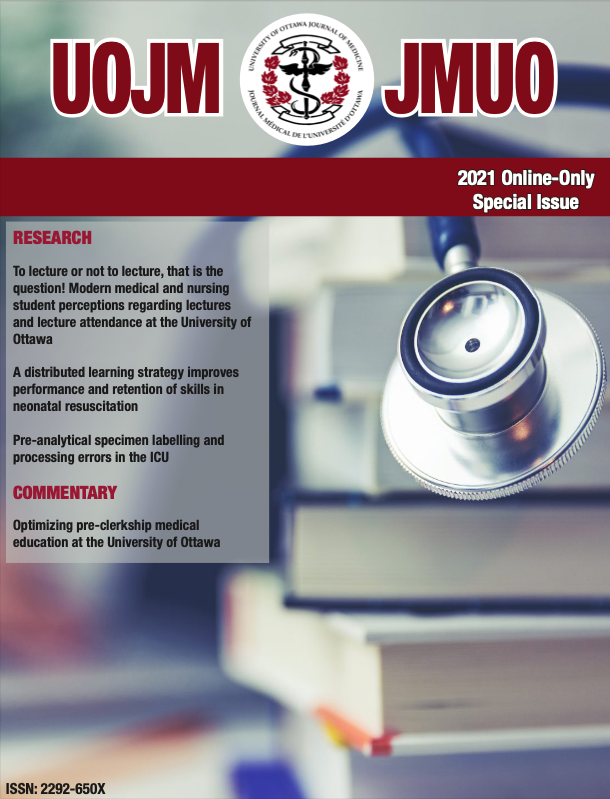To lecture or not to lecture, that is the question! Modern medical and nursing students' perceptions regarding lectures and lecture attendance at the University of Ottawa
To lecture or not to lecture, that is the question!
DOI:
https://doi.org/10.18192/uojm.v11iS5.4986Keywords:
Healthcare education, Traditional lectures, Medicine, Nursing, Student attendanceAbstract
Lecture has historically been a core method used for content delivery in healthcare profession education. However, lecture attendance has decreased within the recent generations of students. The current study focus was to assess the medical and nursing students’ perceptions regarding lecture attendance. To assist with this, second year medical (110/320) and nursing students (95/215) were requested to answer a 10-item survey. The results show that the top reasons why medical and nursing students attended lectures, respectively included: “lectures were mandatory” (81.8% and 68.8%), “socializing with peers” (68.2% and 30.1%), and “professor emphasized important points” (67.3% and 90.3%). While some reasons for students not attending lectures were that the lecture format was not effective (63.5% and 67.7%), students preferred to use recordings of the lectures (43.3% and 18.1%). Overall, 64.6% of medical students and 63.4% of nursing students agree that traditional lectures are an effective way of learning. Sixty two percent of medical students (62% n=68) of medical students stated that traditional lectures is their preferred method of learning compared to flipped classroom (27%), small group learning (30%), and online learning (31%). While (39%) of nursing students stated that traditional lectures is their preferred method of learning compared to flipped classroom (21.5% ), small group learning (3.2%), and online learning (7.4%). The results suggest that there is variability in students’ preferred learning style. While some prefer the face-to-face interaction with the professor, other students favour studying at their own pace. The majority of medical and nursing students think traditional lectures continue to play a major educational role.
Downloads
Additional Files
Published
Issue
Section
License
Copyright (c) 2022 Safaa El Bialy, Dr, Dr, Dr, Dr

This work is licensed under a Creative Commons Attribution-NonCommercial-NoDerivatives 4.0 International License.
- Authors publishing in the UOJM retain copyright of their articles, including all the drafts and the final published version in the journal.
- While UOJM does not retain any rights to the articles submitted, by agreeing to publish in UOJM, authors are granting the journal right of first publication and distribution rights of their articles.
- Authors are free to submit their works to other publications, including journals, institutional repositories or books, with an acknowledgment of its initial publication in UOJM.
- Copies of UOJM are distributed both in print and online, and all materials will be publicly available online. The journal holds no legal responsibility as to how these materials will be used by the public.
- Please ensure that all authors, co-authors and investigators have read and agree to these terms.
- Works are licensed under a Creative Commons Attribution-NonCommercial-NoDerivatives 4.0 International License.


